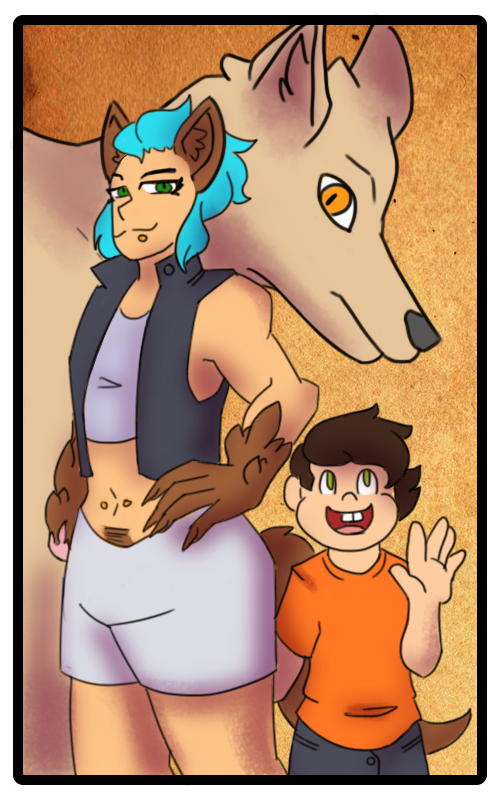Were Rugby
Rugby, but With More Biting!!
“Are you ready for the fur flying, action packed, death defying experience of Pack-sport known as Were-Rugby?!" A loud, hyped up voice boomed over the radio, the sound of animal growls and snarls in the background. They were cheesy as hell, and dimmed as the ad speaker continued, "then come down to the Kennel Arena, and prepare to cheer for your team, this Friday!" The ad ended with a stereotypical wolf howl, and I rolled my eyes, pressing the button to turn the radio off. Couldn't radio ads for Were-Rugby be less of a stereotype? Not all Weres were wolves! That was a dumb fantasy trope....
Intro
The Were Rugby Union, commonly known in most of the world as were rugby, is a contact team sport which originated in Hajev. This variation of Rugby is based on running with the ball in hand and attempting to reach a goal. In its most common form, a game is between two teams of 15 players using an oval-shaped ball on a rectangular field with H-shaped goalposts. While Rugby is a popular sport around the world, Were Rugby is even more popular, due to its thrill factor of its players being capable to shift into predatory animals at the blink of an eye. This sport is played by male and female players of all ages, and is not restricted to one shifting type.A Crash Course on Weres
"What is a were?" You may ask. Weres are a type of Demon, which are capable of holding 3 forms. A Human-Passing form, a Mid-Shift, and a Full or 'Daemon' form, depending on the speaker. While one may think of a stereotypical werewolf scenario, weres are far more varied; in fact, if it is a land living species and is a predator, you're likely to come across one. (For example: wolves, foxes, big cats, badgers, etc). Due to their extreme strength and enhanced healing factor, were rugby is separated from other species, and only play with their own to avoid maiming and death of other species.
The Game at a Glance
If one knows the rules of original rugby, then you'll have no problem following Were Rugby! However, if you don't, the following chapters will ideally give you a passing knowledge of the game.Positions
Each team starts the match with 15 players on the field, having seven or eight substitutes available. Players in a team are divided into eight forwards and seven backs. Depending on their need, different species of weres may take different roles. Forward players for example, tend to be bigger and stronger, and it is not uncommon to see wolves, bears and tiger weres playing as forwards. Because of how dangerous it is to play the hooker. It tends to be a hardier were, such as a badger shifter. While the front row is full of stocky and larger weres the second row tends to be taller, lanky and able to use their height and reach to their advantage. This is similar to their comrades in back row, the flankers, who are the most mobile and tend to be weres like foxes and coyotes, but those species also commonly take roles as the backs due to their smaller stature, and their agility. If a fast were does not choose to take a role as a second row or back row, they can commonly be found as a Wing, as they are usually the fastest players in the team that use their speed to avoid tackles to their smaller frames that may have them taken out of the game.Laws & Rules
- Tackle below the neck!
- No Full Shifts
- Biting is allowed! Exception: No bites to the jugular or arteries.
- No Silver coated equipment or attempts to Silver Poison opponents.
- If the ball is broken and damaged, play will stop to replace equipment.*
*Purposefully popping the ball to shift the tide of the event will be penaltied and the offending player will be benched.- No throwing, or grappling opponents; If a player is tackled, they must pass the ball or drop it.
Components and tools
"Oh, so you're a boot boy, huh?"
"What? I don't understand..." I frowned, turning toward the player that had spoken to me.
The were-- looking to be a panther judging by the ears poking out from her hair, looked down at me, a sneer on her features. Her fangs flashed in the light. "You're wearing boots." she pointed. "Are you really that lame?"
I looked down at my feet. I had...Assumed that boots with spurs were required... "I've...Never played before, aren't they required?" I looked down, noting that she wore no socks, nor boots and instead was barefoot.
She flapped her hand at me. "It's a suggestion."
Depending on the community and level of professionalism, uniform requirements for the sport may vary. It is typical to see teammates dress according to the rules, but varied due to preference.
Uniform & Equipment
Team Uniform
- Jersey
- Shorts
- Knee-high socks (if wearing shoes)*
- Shoes (Spurred; with spurs no longer than half an inch)*
Tools
- Ball
- Referee call cards
Participants
Participants
WeresKey Roles
- Referee
- Assistant Referees (2)
- Medical Staff







Comments